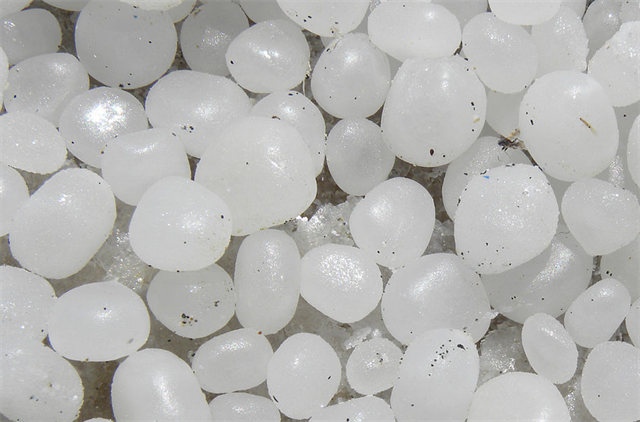What are ooids?
Ooids are small, spheroidal, "coated" (layered) grains, usually composed of calcium carbonate.
Ooid growth is affected by different influencing factors: a saturated solution of calcium carbonate in water, the availability of small particles and forces to put the ooids in motion. These prerequisites are found for example in the shallow waters of tropical seas on the sea floor. The ooid formation starts on the surface of a small particle (also referred to as nucleus), like a grain of sand, a fragment of a shell or small particle of wood with the first layer of precipitate. This precipitation goes on and on, which makes the ooid grow layer by layer. These layers are build from salt crystals arranged radially, tangentially or randomly. Most ooids are aragonite, a special form of calcium carbonate and some are composed of calcite, while some consist of both minerals (layers of calcite and aragonite).
The Dead Sea situation
The mineral content of the Dead Sea is very different from that of ocean water. The exact composition of the Dead Sea water varies mainly with season, depth and temperature. In the early 1980s, the concentration of ionic species (in g/kg) of Dead Sea surface water was Cl− (181.4), Br− (4.2), SO42− (0.4), HCO3− (0.2), Ca2+ (14.1), Na+ (32.5), K+ (6.2) and Mg2+ (35.2). The total salinity was 276 g/kg. (Paragraph copied from Wikipedia monograph "Dead Sea")
Due to its high salinity the Dead Sea is another place, where ooids are formed, not from clacium carbonate, but from salt (sodium chloride). Since the sun evaporates water and the flow to the Dead Sea is limited, it is a saturated solution of salt. Thus the situtation is similar to the one described above for calcium carbonate, that small particles like sand grains form a nucleus on which the salt precipitates layer by layer. The result are halite ooids, which can be found at the shore of the Dead Sea.
Source: Own text based information from Wikipedia and from other webpages
 Halite pebbles: Source Wikipedia
Halite pebbles: Source Wikipedia
To log this Earth Cache, please answer the following questions:
1. Look around at the shore and you will find some of the halite ooids. How large are those ooids you find there? Which other forms of halite do you see at this place? Please describe how they differ from the ooids in the picture.
2. What is the sea level at the coordinates?
3. Will the water level remain the same? What impact will that have on the ooids?
4. Optional: Please make a picture of yourself floating in the Dead Sea. It is a lot of fun! Why can you float in the Dead Sea?
Please be careful that you don't get water into your eyes. Due to the high salinity it burns like hell.
ي المجالات؟ هناك العديد من العوامل التي تؤثر على نمو المجالات: التشبع من المياه فيما يتعلق كربونات الكالسيوم، وتوافر نوى والتحريض من المجالات. يحدث هذا غالبا في البحار الاستوائية الضحلة في قاع البحر. وأشكال المجالات على شكل سلسلة من طبقات متحدة المركز حول نواة. طبقات تحتوي على بلورات مرتبة شعاعيا، بشكل عرضي أو عشوائيا. نواة يمكن أن يكون جزء قذيفة والكوارتز الحبوب أو أي جزء الصغيرة الأخرى. معظم المجالات هي الأراغونيت، والمفصصة من كربونات الكالسيوم. وتتكون بعض من الكالسيت المغنيسيوم عالية، وبعضها (طبقات من الكالسيت وأراجونيت).
الوضع كان البحر الميت المحتوى المعدني للبحر الميت يختلف كثيرا عن ذلك من مياه المحيطات. تكوين الدقيق لمياه البحر الميت تختلف أساسا مع الموسم، وعمق ودرجة الحرارة. في 1980s في وقت مبكر، وكان تركيز الأنواع الأيونية (جم / كجم) من المياه السطحية البحر الميت الكلورين (181.4)، Br- (4.2)، SO42- (0.4)، HCO3- (0.2)، Ca2 + (14.1) ، نا + (32.5)، K + (6.2) وMg2 + (35.2). وكانت ملوحة مجموع 276 جم / كجم. ونظرا لارتفاع نسبة الملوحة في البحر الميت هو مكان آخر، حيث تتشكل ooids، وليس من الكلسيوم كربونات، ولكن من الملح. منذ الشمس يتبخر الماء وتدفق الى البحر الميت محدودة، بل هو محلول مشبع من الملح. وبالتالي فإن حالة يشبه واحد هو موضح أعلاه لكربونات الكالسيوم، أن الجسيمات الصغيرة مثل حبيبات الرمل تشكل نواة الذي يترسب الملح طبقة بعد طبقة. النتيجة هي المجالات الهاليت، التي يمكن العثور عليها على شاطئ البحر الميت.
لتسجيل ذاكرة التخزين المؤقت هذه الأرض، الرجاء الإجابة على الأسئلة التالية: 1. انظر حولك في الشاطئ، وسوف تجد بعض من المجالات الهاليت. كيف كبيرة هي تلك المجالات تجد هناك؟ 2. ما هو مستوى سطح البحر عند الإحداثيات؟ 3. هل يظل مستوى المياه في نفسه؟ ما هو تأثير لها على المجالات؟ 4. اختياري: يرجى تقديم صورة لنفسك العائمة في البحر الميت. ومن الكثير من المرح! ماذا يمكنك أن تعوم في البحر الميت؟ يرجى أن يكون حذرا أن لا تحصل على المياه في عينيك. نظرا لارتفاع نسبة الملوحة يحترق مثل الجحيم.
For friends of banners:
 <br> <a href="https://www.geocaching.com/seek/cache_details.aspx?wp=GC5DPA0&title=halite-ooids-at-the-shore-of-the-dead-sea&guid=05ba7999-df12-41b5-a55a-4705e11a2b62"><img
<br> <a href="https://www.geocaching.com/seek/cache_details.aspx?wp=GC5DPA0&title=halite-ooids-at-the-shore-of-the-dead-sea&guid=05ba7999-df12-41b5-a55a-4705e11a2b62"><img
style="border: 0px solid ;" alt="Banner"
src="https://d1u1p2xjjiahg3.cloudfront.net/1e70426b-957f-426d-ad3f-93a45d700700.jpg?rnd=0.006917298"></a><br>